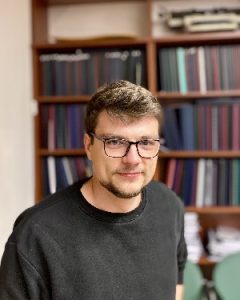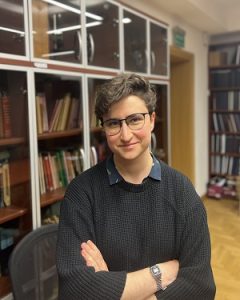
Body-Worn Cameras in Policing and Criminal Justice
(NCN OPUS 2021/41/B/HS5/02988)
Principal Investigator: dr hab. Paweł Waszkiewicz, prof. UW
In May 2021 the Polish Police announced a tender for equipment purchase of over 3100 mobile video cameras mounted on officer’s uniforms (i.e. body-worn cameras, BWCs). The video cameras are to document officers’ daily work – in particular: their interventions. The awareness of being recorded is supposed to make camera-wearing police officers behave more professionally, especially when interacting with civilians. The cameras are to be mounted in plain sight and may additionally emit sounds during the recording, so that they have also a positive impact on the behavior of persons engaged in police interventions, as well as on the bystanders.
The general goal is to improve the relationship between the field officers and civilians. This shall be measured in a reduced need to use means of direct physical coercion and reduced number of complaints filed against police. If a complaint is filed, the recordings are to help with their credibility assessment. On July 17, 2014, an attempted apprehension of Eric Garner suspected of selling untaxed cigarettes, by the NYPD, ended with his death. What led to his death has been documented on video–the recording learly shows how Mr. Garner asked the police to loosen the overpowering grip, claiming he was choking. On April 4, 2015, in North Charleston, Walter Scott was stopped for a traffic control due to inoperative tail lights. Mr. Scott has left the car, pushed the police officer away and began to run when the officer fired 8 rounds at his back and handcuffed him, mortally wounded. In both cases, the recordings were made by bystanders, as the police officers did not have BWCs. These events, among others, raised concerns among civilians and were the source of many protest actions and riots in the US (2014/16). This led to the introduction of the BWCs in the US police units. To improve the situation by reducing the number of deaths caused by police, as well as the number of allegations against the police about evidence falsification in such cases (for clearing police officers of charges). The US government allocated almost $300 million for the purchase of BWC. On May 15, 2016, the apprehension of Igor Stachowiak on the Market Square in Wrocław has led to his death at the police station. He had multiple injuries, including those caused by the repeated use of a stun gun. The official version of the events has been undermined thanks to investigative journalists a year later. This was possible thanks to, among others, a video recordings made by a by-standing witness to Mr. Stachowiak’s apprehension, a city surveillance camera, and a video camera mounted on the stun gun itself. This incident, along with some other polish police force interventions which ended with a civilian death, is being cited as justification for a large-scale introduction of BWCs in Poland.
The proposed empirical research aims to determine the extent to which the introduction of BWCs may affect the work of the Polish Police. Whether and to what extent the goals set and hopes placed in the introduction of the BWCs can be met. This will be obtained through a set of interrelated research methods – both quantitative (such as questionnaire surveys and interviews) as well as qualitative (in-depth research interviews and case studies), and a study of the actual use of BWC (through observation). The planned largescale introduction of BWCs into the Polish Police force provides a chance to research a quasi-experimental model, i.e. to objectively compare how the introduction of BWCs affects the work of Police. It is important to complete the anecdotal stories about the use of BWCs recordings as proof of police falsifying evidence with reliable research results. The comparative aspect of research is just as well important. The relationship between the scale of BWCs use and the compliance with applicable procedures will be examined. The research will also verify the hypothesis about the impact of BWCs on police activities. An important part of the proposed research is also a comparative overview of legal solutions regarding the use of BWCs by the Police: what are the possibilities and how personal and human rights are being guaranteed.
Based on the results obtained through the study, a theoretical model of using BWCs in the work of Police will be developed. In addition to strictly cognitive value, research results may be used to inform future decision-making processes regarding the design of an effective and safe law enforcement policy that will be also safe for the
citizens (in terms of preserving their rights and freedoms, which may be easily affected when using BWCs).
Publications:
Conference presentations:
- Qualitative insights from individual in-depth interviews with experts on Body-Worn Cameras, Eurocrim 2024 – 24th Annual Conference of the European Society of Criminology, Bucharest 11-15 September 2024 (P.Lewulis, P.Waszkiewicz).
- Body Cameras in Uniformed Services: Preliminary Conclusions from Expert Interviews, XXV Conference of the Faculty of Law and Administration at the University of Warsaw, April 5, 2024. (P. Lewulis, G. Jost).
- Gathering Information from the Police – Challenges in the Context of Research on the Use of Body Cameras by Law Enforcement Agencies, XXV Conference of the Faculty of Law and Administration at the University of Warsaw, April 5, 2024. (M. Tomaszewska-Michalak, Ł. Kuliński).
- Body Cameras in Law Enforcement and the Justice System – Polish Regulations in the Context of Selected Foreign Legislation, XXV Conference of the Faculty of Law and Administration at the University of Warsaw, April 5, 2024. (J. Kupczyński, Z. Ganczewska).
- Body-worn cameras in policing and criminal justice – research methods and the related hypotheses, Eurocrim 2022 – 22nd annual conference of the ESC , Malaga 21-24 September 2022 r. (P.Lewulis, P.Waszkiewicz, M.Tomaszewska-Michalak).
- Kamery nasobne w pracy organów ścigania i wymiaru sprawiedliwości – przyjęte metody badań ilościowych i powiązane z nimi hipotezy, II Kongres Kryminologiczny, Uniwersytet Jagielloński, 8-9 września 2022 r. (M. Tomaszewska-Michalak).
- Kamery nasobne w pracy organów ścigania i wymiaru sprawiedliwości – przyjęte metody badań jakościowych i powiązane z nimi hipotezy, II Kongres Kryminologiczny, Uniwersytet Jagielloński, 8-9 września 2022 r. (P. Lewulis).
- Kamery nasobne w pracy organów ścigania i wymiaru sprawiedliwości – dane o aktualnym wykorzystaniu kamer w ujęciu faktycznym i prawnym, II Kongres Kryminologiczny, Uniwersytet Jagielloński, 8-9 września 2022 r. (J. Kupczyński).
- Kamery nasobne w pracy organów ścigania i wymiaru sprawiedliwości – kolejne cudowne remedium czy nowa jakość?, II Kongres Kryminologiczny, Uniwersytet Jagielloński, 8-9 września 2022 r. (P. Waszkiewicz).
Research team:

Dr hab. Paweł Waszkiewicz prof. UW –
Principal Investigator, Professor at the Department of Criminalistics of the Faculty of Law and Administration at the University of Warsaw. He has led and co-organized research on crime prevention, video monitoring, biometrics, operational and investigative work, murder investigations, methods of surveillance, social media, and out-of-court dispute resolution, including a project entitled “Social Media in the Work of Law Enforcement Agencies” (no. 2018/31/B/HS5/01876) funded by the National Science Centre under the OPUS programme. An advocate for transparency and open access. In love with surfing, without reciprocity.

Dr Magdalena Tomaszewska-Michalak –
Graduated from the Faculty of Law and Administration at the University of Warsaw, a doctor of legal sciences, and an assistant professor in the Department of Internal Security at the Faculty of Political Science and International Studies; research interests: Criminalistics, biometric technology, issues related to security and privacy, and the penal system.

Dr Piotr Lewulis –
Associate professor in the Department of Criminalistics at the Faculty of Law and Administration of the University of Warsaw, holds a Ph.D in Social Sciences in the discipline of Law. Academically interested in researching the legal and forensic aspects of new technologies and communication tools and their impact on the pathologies in the digital space. In his free time, he is involved in mountain sports.

Mgr Jędrzej Kupczyński –
Prosecutor at the Regional Prosecutor’s Office in Warsaw-Wola in Warsaw. He igraduated from the Faculty of Law and Administration at the University of Warsaw and from the National School of Judiciary and Prosecution. His scientific interests include criminalistics, particularly mechanoscopy and issues of mechanical property protection and burglary tactics. Co-author of the book “Strategy of Contemporary Burglar Action” (Central Criminalistic Laboratory of the Police, Warsaw 2015). Professionally connected with issues of investment crime. In his spare time he goes hiking, cycling and diving.

Łukasz Kuliński –
Second-year Master’s student majoring in Criminology (IPSIR UW). Professionally interested in restorative justice, criminal policy, and penology. In free time enjoys cycling and playing badminton.

Gabriela Jost –
A law graduate with a master’s degree from the University of Warsaw, specializing in Internal Security, he professionally addresses matters concerning the protection of personal data and Artificial Intelligence. Additionally, he harbors a keen interest in bilingual criminal proceedings in Canada.

Zuzanna Ganczewska –
A law graduate from the Faculty of Law and Administration at the University of Warsaw, involved with the Legal Intervention Program of the Helsinki Foundation for Human Rights. She focuses on preventing torture and protecting human rights in criminal proceedings.
